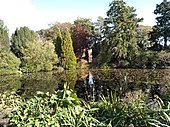Altamont House
| Altamont House | |
|---|---|
 | |
 | |
| General information | |
| Type | Country House |
| Location | Tullow, County Carlow, Ireland |
| Construction started | 1740 |
| Completed | 1780 |
| Owner | Government of Ireland |
| Website | |
| http://heritageireland.ie/visit/places-to-visit/altamont-gardens/ | |
Altamont House is a historic building best known for its ornamental gardens in County Carlow. The Robinsonian-style gardens[1] are often referred to as "the jewel in Ireland's gardening crown".[2]
History[edit]
The early origins of the house are unclear, with some claiming that the building was first built as a convent,[3] perhaps dating as far back as the 16th century.[4] The central section of the house dates from the 18th century and the sections that face the east remain unchanged, were built by the St George family.[5] Most of these changes to the house were to reverse it to face a newly built road.[4] During the 1780s, Benjamin Burton Doyle the High Sheriff of Carlow lived at the house.[4] In the 1840s the Dawson Borrer family refurbished and altered the house and gardens, adding the lake that was dug as relief work for the local population during the Irish famine.[3]
Feilding Lecky Watson bought Altamont in 1923, and proceeded to extend and expand the gardens.[5] Watson's interest was primarily in rhododendrons, planting seedlings from around the world and exchanging specimens with Sir Frederick Moore of the National Botanic Gardens.[6] Following Watson's death in 1943, his daughter, Corona North continued her father's horticultural work.[7]
Gardens[edit]
The garden sits on the banks of River Slaney which includes an ice age glen, bog garden and arboretum, with view of the Blackstairs Mountains, Wicklow Mountains and Mount Leinster.[2] Some of the oaks are believed to be over 500 years old,[8] and the varying environments provide habitats for diverse set of wildlife.[2] The garden is home to a variety of rare azaleas, rhododendrons, magnolias,[9] as well as wild bluebells and snowdrops.[10] The gardens also feature a Wellingtonia, the Sequoiadendron giganteum or Giant Redwood, which was planted to commemorate the Battle of Waterloo.[4]
A trust was set up in the early 1990s to preserve the estate of 100 acres.[4] Following the death of Corona North, ownership of the house and gardens was transferred to the Irish State, and is operated by the Office of Public Works.[11][12]
Gallery[edit]
See also[edit]
References[edit]
- ^ "Altamont Gardens". Houses, Castles and Gardens of Ireland. Archived from the original on 20 July 2015. Retrieved 2 May 2015.
- ^ a b c "Altamont Garden". Ask About Ireland. Retrieved 2 May 2015.
- ^ a b "A Brief History of Altamont House and Garden". Altamont Garden. Archived from the original on 4 February 2015. Retrieved 2 May 2015.
- ^ a b c d e O'Toole, Jimmy (1993). The Carlow Gentry. Carlow: The Leinster Leader. ISBN 0952254409.
- ^ a b "Altamont, County Carlow". Ireland's Eye. Retrieved 2 May 2015.
- ^ Taylor, Patrick (2008). Gardens of Britain and Ireland. London: Dorling Kindersley Ltd. p. 218. ISBN 9781405336253.
- ^ Powers, Jane (24 May 1997). "A Passion For Rhododendrons". The Irish Times. Retrieved 2 May 2015.
- ^ "Altamont House & Gardens". Do Chara. Retrieved 2 May 2015.
- ^ "Corona North 1922 - 1999". Altamont Gardens. Archived from the original on 4 February 2015. Retrieved 2 May 2015.
- ^ Fallon, Fionnuala (18 January 2014). "A sprinkling of spring". The Irish Times. Retrieved 2 May 2015.
- ^ "A Gift to the Nation". The Nationalist. 21 January 2014. Retrieved 2 May 2015.
- ^ "Keys of Altamont are handed over to State". Carlow People. 28 January 2014. Retrieved 2 May 2015.




